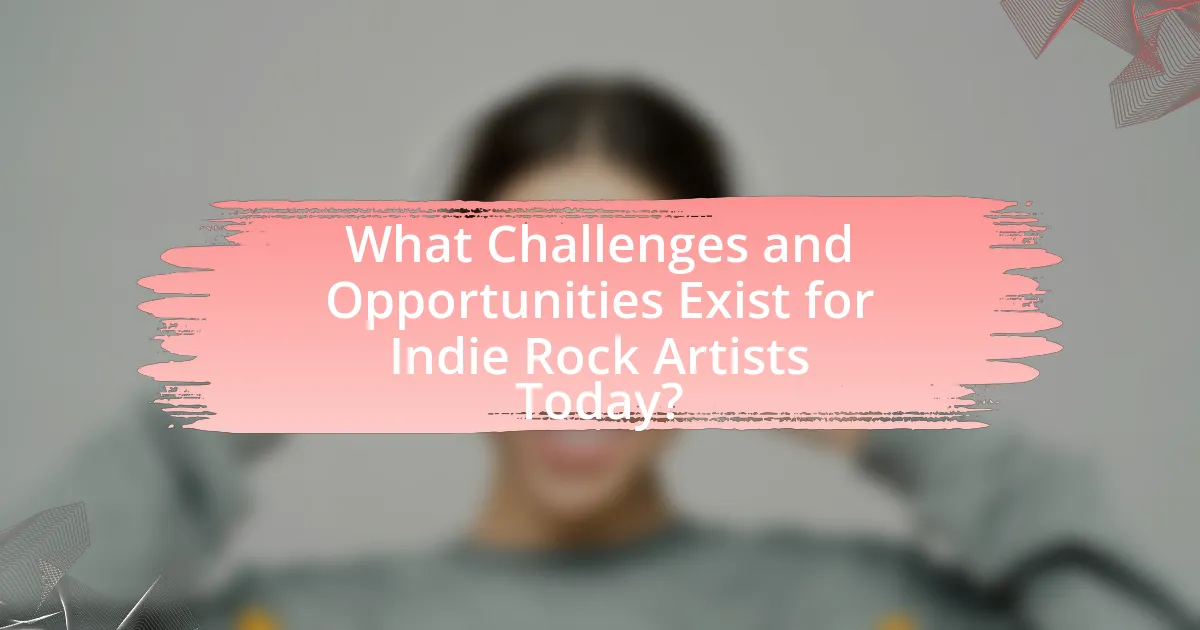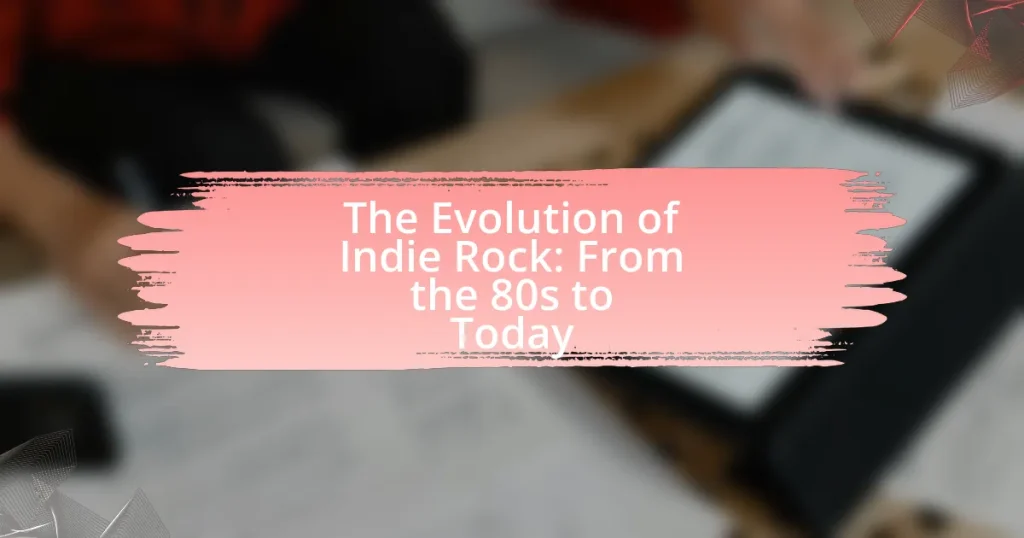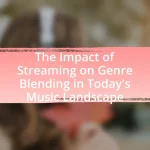Indie rock is a genre of alternative rock music that originated in the 1980s, characterized by independent production and distribution outside major record labels. The article explores the evolution of indie rock, highlighting its roots in the DIY ethic and the influence of key bands such as R.E.M., The Smiths, and Sonic Youth. It examines the genre’s transformation through the decades, including the impact of digital distribution and social media on contemporary indie artists. Additionally, the article discusses the challenges and opportunities faced by indie musicians today, emphasizing the importance of diversity and inclusivity within the indie rock scene.

What is Indie Rock and How Did It Evolve?
Indie rock is a genre of alternative rock music that emerged in the 1980s, characterized by its independent production and distribution, often outside of major record labels. The evolution of indie rock began with bands like R.E.M. and The Smiths, who gained popularity through college radio and independent labels, setting the stage for a diverse range of sounds and styles. In the 1990s, the genre expanded with the rise of bands such as Pavement and Neutral Milk Hotel, which embraced lo-fi aesthetics and eclectic influences. The 2000s saw a further evolution with the emergence of bands like The Strokes and Arcade Fire, who blended indie rock with mainstream appeal, leading to a broader acceptance of the genre. Today, indie rock continues to evolve, incorporating elements from various genres and maintaining its ethos of artistic independence.
What are the origins of Indie Rock in the 1980s?
Indie rock originated in the 1980s as a response to the mainstream music industry’s commercialization and homogenization of sound. The genre emerged from the independent music scene, characterized by DIY ethics and a focus on artistic freedom, with bands like R.E.M. and The Smiths leading the way. These artists often released music through independent labels, such as SST Records and 4AD, which allowed them to maintain creative control and connect with niche audiences. The rise of college radio stations further propelled indie rock’s popularity, providing a platform for these bands to reach listeners who sought alternatives to mainstream pop and rock music.
How did the DIY ethic shape the early Indie Rock scene?
The DIY ethic fundamentally shaped the early Indie Rock scene by promoting self-sufficiency and artistic independence among musicians. This approach allowed artists to produce, distribute, and promote their music without relying on major record labels, fostering a culture of creativity and experimentation. For instance, bands like Sonic Youth and The Replacements recorded albums in home studios and released them through independent labels, which exemplified the DIY spirit. This movement not only encouraged a diverse range of sounds and styles but also created a community where musicians supported one another, leading to the establishment of independent venues and festivals that further nurtured the Indie Rock genre.
What key bands and artists emerged during the 80s?
Key bands and artists that emerged during the 80s include R.E.M., The Smiths, and Sonic Youth. R.E.M. is recognized for pioneering alternative rock with their 1983 debut album “Murmur,” which received critical acclaim and commercial success. The Smiths, formed in 1982, became influential in the indie music scene with their unique sound and lyrics, particularly through albums like “The Queen Is Dead” released in 1986. Sonic Youth, known for their experimental approach to rock music, gained prominence with their 1988 album “Daydream Nation,” which is often cited as a landmark in alternative rock. These bands significantly shaped the indie rock genre and influenced countless artists in subsequent decades.
How did the sound of Indie Rock change throughout the decades?
The sound of Indie Rock evolved significantly from the 1980s to the present, transitioning from lo-fi, DIY aesthetics to more polished and diverse production styles. In the 1980s, Indie Rock was characterized by its raw sound, influenced by punk and post-punk bands like The Smiths and R.E.M., who emphasized jangly guitars and introspective lyrics. The 1990s saw the rise of grunge and alternative rock, with bands like Nirvana and Radiohead incorporating heavier sounds and broader emotional themes, leading to a more mainstream acceptance of the genre.
By the 2000s, Indie Rock diversified further, with the emergence of subgenres such as indie pop and indie folk, exemplified by artists like The Shins and Sufjan Stevens, who utilized intricate arrangements and varied instrumentation. The 2010s introduced electronic elements and genre-blending, as seen in the works of bands like Tame Impala and Vampire Weekend, reflecting a shift towards experimentation and production sophistication.
Overall, the sound of Indie Rock has transformed from its initial rawness to a more complex and varied musical landscape, mirroring broader trends in music production and cultural influences over the decades.
What musical influences contributed to the evolution of Indie Rock?
Indie Rock evolved through a blend of various musical influences, primarily drawing from punk rock, post-punk, and alternative rock. Punk rock’s DIY ethos and raw sound inspired early Indie Rock bands, while post-punk introduced experimental elements and a focus on artistic expression. Additionally, the influence of alternative rock in the 1980s and 1990s, characterized by its diverse sounds and rejection of mainstream conventions, further shaped the genre. The combination of these influences led to the distinctive sound and culture of Indie Rock, which emphasizes independence and artistic integrity.
How did production techniques impact the genre’s development?
Production techniques significantly influenced the development of indie rock by enabling artists to achieve a distinct sound and greater creative control. In the 1980s, the advent of affordable recording technology, such as four-track recorders, allowed independent musicians to produce high-quality recordings without the need for major label backing. This democratization of music production led to a surge in diverse sounds and styles within the genre, as artists experimented with lo-fi aesthetics and unconventional song structures. For instance, bands like The Pixies and Sonic Youth utilized innovative recording methods to create unique sonic textures that became hallmarks of the genre. Additionally, the rise of digital production tools in the 1990s further expanded the possibilities for indie rock artists, allowing for intricate layering and manipulation of sound, which contributed to the genre’s evolution and mainstream acceptance.
Why is the 90s considered a pivotal decade for Indie Rock?
The 90s is considered a pivotal decade for Indie Rock because it marked the genre’s significant mainstream breakthrough and diversification. During this period, bands like Nirvana, Radiohead, and Pavement gained widespread recognition, leading to increased visibility for independent labels and artists. The success of Nirvana’s “Nevermind” in 1991, which sold over 30 million copies worldwide, exemplified how Indie Rock could achieve commercial success while maintaining its artistic integrity. Additionally, the rise of alternative rock radio and festivals like Lollapalooza provided platforms for Indie bands, further solidifying the genre’s influence in the music industry.
What role did independent labels play in the growth of Indie Rock?
Independent labels were crucial in the growth of Indie Rock by providing a platform for diverse and innovative artists outside the mainstream music industry. These labels, such as Sub Pop and Matador, emerged in the 1980s and 1990s, allowing musicians to produce and distribute their music independently, which fostered creativity and experimentation. The success of bands like Nirvana and Pavement, who were signed to independent labels, demonstrated that alternative sounds could achieve commercial success, influencing the broader music landscape. Furthermore, independent labels often prioritized artistic integrity over commercial viability, enabling artists to maintain their unique identities and connect with niche audiences, which contributed to the genre’s expansion and popularity.
How did the rise of alternative rock influence Indie bands?
The rise of alternative rock significantly influenced Indie bands by expanding their musical boundaries and increasing their visibility in the mainstream music scene. As alternative rock gained popularity in the late 1980s and 1990s, it created a cultural shift that encouraged Indie bands to experiment with diverse sounds and styles, blending genres such as punk, folk, and electronic music. This shift is evidenced by the success of bands like Radiohead and Nirvana, which paved the way for Indie artists to gain recognition and access to larger audiences. Consequently, the influence of alternative rock led to a flourishing Indie scene characterized by greater artistic freedom and innovation, as seen in the emergence of bands like The Strokes and Arcade Fire, who drew inspiration from the alternative rock ethos while maintaining their independent spirit.

What are the Major Trends in Indie Rock from the 2000s to Today?
Major trends in indie rock from the 2000s to today include the rise of digital distribution, the blending of genres, and increased diversity in sound and representation. Digital platforms like Bandcamp and streaming services have democratized music distribution, allowing independent artists to reach wider audiences without traditional label support. The blending of genres has led to innovative sounds, with artists incorporating elements from electronic, hip-hop, and pop into their music, exemplified by bands like Tame Impala and MGMT. Additionally, there has been a notable increase in diversity, with more artists from various backgrounds gaining recognition, as seen in the success of artists like Haim and Lizzo. These trends reflect the evolving landscape of indie rock, shaped by technological advancements and cultural shifts.
How has the digital age transformed the Indie Rock landscape?
The digital age has transformed the Indie Rock landscape by enabling artists to distribute their music independently and reach global audiences without traditional record label support. This shift has been facilitated by platforms like Bandcamp, SoundCloud, and Spotify, which allow musicians to upload and promote their work directly to listeners. As a result, the number of Indie Rock bands has surged, with over 40% of new music releases in recent years classified as independent, according to the Recording Industry Association of America (RIAA). Additionally, social media has become a crucial tool for marketing and fan engagement, allowing artists to cultivate dedicated followings and interact with fans in real-time. This democratization of music distribution and promotion has significantly altered the dynamics of the Indie Rock scene, fostering a diverse array of sounds and styles that reflect a broader range of influences and cultural backgrounds.
What impact did streaming services have on Indie artists?
Streaming services have significantly democratized access to music for Indie artists, allowing them to reach wider audiences without the need for traditional record label support. This shift has enabled Indie musicians to distribute their music globally, resulting in increased visibility and potential revenue streams. According to a 2021 report by the Music Industry Association, independent artists saw a 35% increase in streaming revenue compared to previous years, highlighting the financial benefits of these platforms. Additionally, platforms like Spotify and Bandcamp have provided tools for artists to engage directly with fans, fostering community and loyalty.
How did social media change the way Indie bands connect with fans?
Social media transformed the way Indie bands connect with fans by enabling direct communication and engagement without the need for traditional media intermediaries. Platforms like Facebook, Instagram, and Twitter allow bands to share updates, promote new music, and interact with fans in real-time, fostering a sense of community. For instance, a 2019 study by the University of Southern California found that 70% of Indie bands reported increased fan engagement through social media, highlighting its role in building loyal followings and facilitating grassroots marketing. This shift has democratized the music industry, allowing Indie bands to reach wider audiences and cultivate relationships that were previously difficult to establish.
What are the defining characteristics of contemporary Indie Rock?
Contemporary Indie Rock is characterized by its diverse sound, DIY ethos, and a blend of various musical influences. This genre often features unconventional song structures, introspective lyrics, and a focus on artistic expression over commercial success. The use of lo-fi production techniques and a preference for independent labels further distinguish contemporary Indie Rock from mainstream music. Additionally, the genre frequently incorporates elements from genres such as folk, electronic, and punk, reflecting a broad range of influences that appeal to a wide audience.
How do modern Indie bands blend genres and styles?
Modern Indie bands blend genres and styles by incorporating elements from various musical traditions, resulting in a diverse sound that defies traditional categorization. This blending often includes influences from rock, pop, electronic, folk, and hip-hop, allowing bands to experiment with different rhythms, melodies, and instrumentation. For instance, bands like Tame Impala fuse psychedelic rock with electronic music, while others like Vampire Weekend mix indie rock with Afrobeat influences. This genre fluidity is facilitated by the accessibility of digital recording technology and platforms, enabling artists to collaborate across genres and reach wider audiences. The result is a rich tapestry of sounds that reflects contemporary cultural influences and personal artistic expression.
What themes and messages are prevalent in today’s Indie Rock music?
Today’s Indie Rock music prominently features themes of personal introspection, social commentary, and emotional vulnerability. Artists often explore individual experiences, mental health issues, and the complexities of modern relationships, reflecting a broader cultural shift towards openness and authenticity. For instance, songs frequently address topics like anxiety, identity, and societal pressures, resonating with listeners who seek connection through shared struggles. This trend aligns with the rise of DIY ethics in the genre, where musicians prioritize genuine expression over commercial success, further emphasizing the importance of personal narratives and social awareness in contemporary Indie Rock.
Why is diversity important in the current Indie Rock scene?
Diversity is important in the current Indie Rock scene because it fosters innovation and broadens the genre’s appeal. A diverse range of artists brings unique perspectives, influences, and sounds, which enriches the music and attracts a wider audience. For instance, the rise of artists from various cultural backgrounds has led to the incorporation of different musical styles, such as hip-hop, electronic, and world music elements into Indie Rock, creating a more dynamic and varied soundscape. This evolution is evident in the success of artists like Mitski and Hozier, who blend genres and themes that resonate with diverse listeners, thereby expanding the reach and relevance of Indie Rock in today’s music industry.
How are underrepresented voices shaping the future of Indie Rock?
Underrepresented voices are shaping the future of Indie Rock by introducing diverse perspectives and innovative sounds that challenge traditional genre boundaries. Artists from marginalized communities are gaining visibility through platforms like Bandcamp and social media, allowing them to reach wider audiences without relying on major labels. For instance, the rise of artists such as Mitski and Phoebe Bridgers highlights how unique narratives and experiences can resonate with listeners, leading to increased representation in the genre. Additionally, studies show that diversity in music leads to richer artistic expression and broader appeal, as evidenced by the growing popularity of genres like Latinx rock and queer punk. This shift not only enriches the Indie Rock landscape but also fosters a more inclusive music culture that reflects a wider array of human experiences.
What initiatives support inclusivity within the Indie music community?
Initiatives that support inclusivity within the Indie music community include organizations like Girls Rock Camp, which empowers young women and gender non-conforming individuals through music education and mentorship. Additionally, the Music Industry Black Out movement advocates for racial equality and representation in the music industry, promoting diverse voices and artists. Furthermore, platforms such as Bandcamp have implemented features to support marginalized artists, allowing them to reach wider audiences and retain more revenue from their sales. These initiatives collectively foster a more inclusive environment, ensuring that diverse perspectives are represented and valued within the Indie music scene.

What Challenges and Opportunities Exist for Indie Rock Artists Today?
Indie rock artists today face significant challenges such as market saturation and limited financial resources, while also benefiting from opportunities like digital distribution and social media marketing. The rise of streaming platforms has made it easier for indie artists to reach global audiences, with 2022 statistics showing that independent artists accounted for 40% of all music streamed in the U.S. However, the same platforms create intense competition, making it difficult for individual artists to stand out. Additionally, many indie artists struggle with funding for tours and production, as traditional record label support has diminished. Despite these hurdles, the ability to connect directly with fans through social media allows for innovative marketing strategies and community building, which can lead to sustainable careers.
What are the common challenges faced by Indie Rock musicians?
Indie Rock musicians commonly face challenges such as limited financial resources, difficulty in gaining mainstream exposure, and issues with distribution and marketing. Financial constraints often hinder their ability to produce high-quality recordings and promote their music effectively. Additionally, while the indie scene allows for creative freedom, it can also lead to struggles in reaching wider audiences, as many indie artists lack the backing of major record labels that provide marketing support. Furthermore, navigating the complexities of digital distribution and social media can be overwhelming, making it hard for these musicians to establish a strong online presence and connect with fans.
How do financial constraints affect the production and promotion of Indie music?
Financial constraints significantly limit the production and promotion of Indie music by restricting access to quality recording facilities, marketing resources, and distribution channels. Indie artists often rely on personal funds or crowdfunding, which can lead to lower production values and limited promotional reach. For instance, a study by the University of Southern California found that 70% of Indie musicians reported financial limitations as a primary barrier to producing high-quality recordings. Additionally, without substantial marketing budgets, Indie artists struggle to gain visibility in a crowded music market, often relying on social media and grassroots efforts, which may not yield the same results as traditional promotional strategies.
What obstacles do Indie artists encounter in gaining mainstream recognition?
Indie artists encounter several obstacles in gaining mainstream recognition, primarily including limited access to major distribution channels, insufficient marketing budgets, and a lack of industry connections. Limited access to major distribution channels restricts their ability to reach wider audiences, as many mainstream platforms prioritize established artists. Insufficient marketing budgets hinder their promotional efforts, making it difficult to compete with well-funded major label artists. Additionally, a lack of industry connections can prevent indie artists from securing opportunities such as radio play, festival slots, and collaborations that are crucial for visibility in the mainstream music scene. These factors collectively contribute to the challenges indie artists face in achieving broader recognition.
What opportunities are available for Indie Rock artists in the current music industry?
Indie Rock artists currently have numerous opportunities in the music industry, including digital distribution, social media marketing, and live performances. Digital platforms like Spotify and Bandcamp allow artists to distribute their music globally without the need for a traditional record label, enabling them to reach wider audiences. Social media platforms such as Instagram and TikTok provide effective marketing tools for artists to engage with fans and promote their music directly. Additionally, the rise of virtual concerts and local gigs has created new avenues for live performances, allowing artists to connect with audiences in innovative ways. According to a 2022 report by the International Federation of the Phonographic Industry, independent labels accounted for 40% of global music sales, highlighting the growing influence and opportunities for Indie Rock artists in the current landscape.
How can Indie musicians leverage technology for their benefit?
Indie musicians can leverage technology by utilizing digital distribution platforms, social media, and music production software to enhance their reach and creativity. Digital distribution platforms like Spotify and Bandcamp allow indie artists to distribute their music globally without the need for a record label, enabling them to retain a larger share of their earnings. Social media platforms such as Instagram and TikTok provide avenues for direct engagement with fans, facilitating marketing and promotion at a low cost. Additionally, music production software like Ableton Live and GarageBand empowers musicians to create high-quality recordings from home, reducing the need for expensive studio time. These technological advancements have democratized the music industry, allowing indie musicians to thrive independently.
What role do live performances play in the success of Indie bands?
Live performances are crucial for the success of Indie bands as they provide a platform for direct audience engagement and community building. These performances allow bands to showcase their unique sound and artistic identity, which is essential in a genre characterized by diversity and individuality. According to a 2020 study by the University of Southern California, live shows significantly contribute to an artist’s revenue, with 75% of musicians reporting that touring is their primary income source. Additionally, live performances help Indie bands cultivate a loyal fan base, as fans often connect more deeply with artists through the shared experience of a concert. This connection can lead to increased merchandise sales and streaming numbers, further solidifying the band’s success in the competitive music industry.
What practical tips can Indie Rock artists follow to thrive in today’s market?
Indie Rock artists can thrive in today’s market by leveraging digital platforms for music distribution and fan engagement. Utilizing streaming services like Spotify and Apple Music allows artists to reach a global audience, while social media platforms such as Instagram and TikTok enable direct interaction with fans, fostering a loyal community. According to a 2021 report by the International Federation of the Phonographic Industry, streaming accounted for 62% of global recorded music revenue, highlighting its importance for indie artists. Additionally, artists should focus on building a strong brand identity and engaging in live performances, as live music remains a significant revenue stream, contributing to 27% of the total music industry revenue in 2022. By combining digital strategies with traditional performance opportunities, Indie Rock artists can effectively navigate and succeed in the current music landscape.


